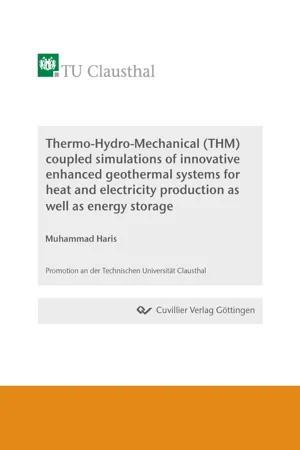
- 172 pages
- English
- PDF
- Available on iOS & Android
About this book
Enhanced geothermal systems (EGSs) evolved from the hot dry rock can provide a significant amount of energy while shifting towards negligible carbon emission. In order to investigate some important issues related to EGS, several scenarios have been analyzed using powerful numerical tools (FLAC3Dplus and TOUGH2MP-TMVOC). While conducting multiple hydraulic fracturing, it is observed that the newly created successive fracture's configuration highly depends on the previous one under the influence of stress shadow. Therefore, the assumption of using similar multiple fracture geometries and shapes for energy exploitation may lead to erroneous estimations. A case study has been performed further using the engineering data of the GeneSys project in the North German Basin. Numerous scenarios have been investigated, and the optimized EGS project is proposed, whose installed power capacity of one side of the injection well declines from 7.17 MW to 5.08 MW over 30 years. Moreover, the Levelized cost of electricity is calculated at 5.46 c$/kWh, which is quite economical compared to the current electricity price. Finally, an innovative concept of regenerative EGS is proposed by storing surplus renewable energy in multiple hydraulic fractures that can reduce the reservoir temperature reduction rate. The results of continuous injection/production cycles depicted that a regenerative EGS could be achieved in reality.
Frequently asked questions
- Essential is ideal for learners and professionals who enjoy exploring a wide range of subjects. Access the Essential Library with 800,000+ trusted titles and best-sellers across business, personal growth, and the humanities. Includes unlimited reading time and Standard Read Aloud voice.
- Complete: Perfect for advanced learners and researchers needing full, unrestricted access. Unlock 1.4M+ books across hundreds of subjects, including academic and specialized titles. The Complete Plan also includes advanced features like Premium Read Aloud and Research Assistant.
Please note we cannot support devices running on iOS 13 and Android 7 or earlier. Learn more about using the app.
Information
Table of contents
- 1 Introduction
- 1.1 Motivation and objectives
- 1.2 Thesis outline
- 2 Fundamentals of geothermal reservoirs and hydraulicfracturing
- 2.1 Geothermal reservoirs
- 2.2 Worldwide EGS projects
- 2.3 Geomechanics involved during hydraulic fracturing
- 2.4 Modeling of hydraulic fracturing
- 2.5 Significance of wellbore orientation on hydraulic fracturing
- 3 Numerical study of geothermal heat production throughmultiple hydraulic fractures in a horizontal well inconsideration with stress shadow effects
- 3.1 Overview of the role of hydraulic fracturing in EGS Exploitation
- 3.2 Application of FLAC3Dplus for modeling hydraulic fracturing
- 3.3 Governing equations for heat transmission
- 3.4 Fluid flow in rock formation (TOUGH2MP-TMVOC)
- 3.5 Numerical study of multiple hydraulic fracturing and heat productionthrough a fictive model
- 4 Geothermal exploitation through massive multiple hydraulicfractures; a case study of a geothermal field in the NorthGerman Basin (MHH-GeneSys)
- 4.1 Overview of the EGS project – (GeneSys)
- 4.2 Multiple hydraulic fracturing
- 4.3 Geothermal exploitation through configured multiple fracture model
- 4.4 Economic analysis
- 5 Regenerative EGS using surplus wind & solar energy
- 5.1 Introduction
- 5.2 Energy storage and recovery in hydraulically fractured EGS
- 5.3 Continuous injection/production cycles
- 6 Conclusion
- 7 References